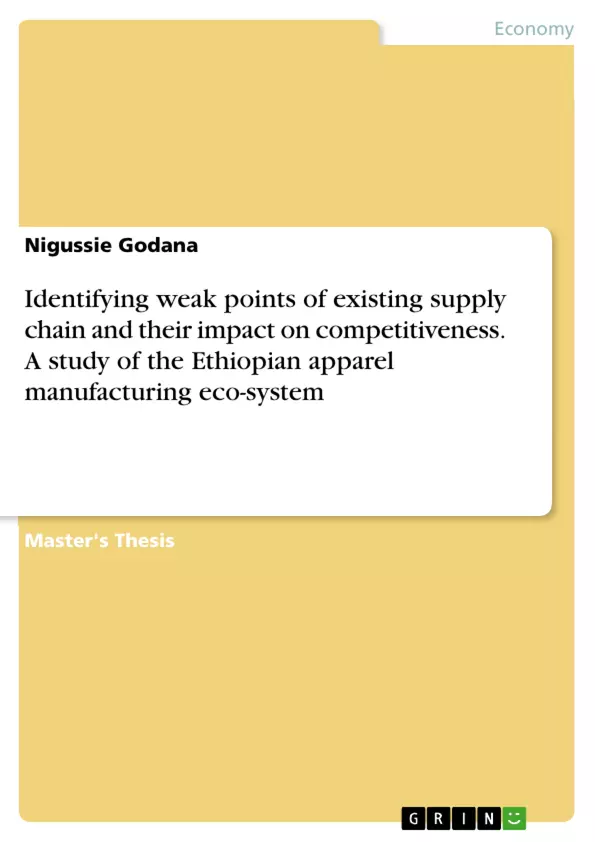This study focusses on reviewing apparel manufacturing eco-systems of Ethiopia, identifying missing inputs (weak points) of existing supply chain and assessing their impact on competitiveness of Ethiopian Apparel manufacturing firms.
Countries compete with each other to improve the standard of living and quality of life of their citizens, grow economically, attract foreign investments and tourists, maintain political stability and build their own brand image by using competitive advantage of their nations. Apart from favourable Macro environment (GDP, purchasing power, Economic freedom, easy of doing business, and political stability) low Production factors such as rawmaterials, related and supplying industries, electric cost and skilled and semiskilled manpower are the source of competitive advantage both to the countries and firms along the supply chain.
The textile and clothing industry have been one of the most dynamic and geographically mobile industries globally. The industry is made up of complex global production networks and due to the possibilities of minimizing the costs of production, many buying companies use suppliers located in developing countries and manufacturers of textile and clothing companies also relocate themselves in developing countries through foreign direct investment (FDI). Over recent years there has been an increasing amount of interest in Africa for investment as a continent with immense resources and potential. Ethiopia in particular has been singled out as a land of growth and investment opportunity.
Ethiopia grows some of the world‘s finest cotton and has a rich textile spinning and weaving history, yet its importance on a global scale remains insignificant. Having experienced average annual growth rate of 10.7% GDP growth consistently since 2006 and a stable political framework since 1995, it still remains largely, not yet used or taken advantage of it.
Although, favourable business environment is set by the government, there are ―missing inputs (weak points)‖ in existing supply chain which should be addressed. For example, in the case of garment manufacturing, trimming and accessories, packaging, certification bodies, spare part technology and machine maintenance companies and Ecommerce are missed along the supply chain.
Inhaltsverzeichnis (Table of Contents)
- Acknowledgement
- Executive Summary
- Table of contents
- List of tables
- List of figures
- List of Abbreviations
- Chapter one: Background
- Introduction
- Summary of research approaches
- Statement of the problem
- Chapter two: Review of the literature
- Theoretical Framework
- Porter's national Diamond model
- Supply chain Management
- Theoretical Framework
- Chapter Three: Research methodology
- Research questions
- Objectives
- Methodology
- Research Design
- Data collection
- Sampling methods and size
- Significance of the study
Zielsetzung und Themenschwerpunkte (Objectives and Key Themes)
This research project aims to analyze the Ethiopian apparel manufacturing ecosystem, identifying weak points within the existing supply chain and their impact on competitiveness in the international market. The study was conducted by Silver Spark Apparel LTD (Raymond) to gain a comprehensive understanding of the business environment and competitive advantages and disadvantages of the Ethiopian garment industry.
- Analysis of the Ethiopian apparel manufacturing ecosystem
- Identification of weak areas in the existing supply chain
- Assessment of the impact of these weak areas on competitiveness in the international market
- Exploration of potential solutions and recommendations for improvement
- Evaluation of government support and industry partnerships
Zusammenfassung der Kapitel (Chapter Summaries)
Chapter one: Background introduces the study's context and provides an overview of the Ethiopian apparel manufacturing industry. It delves into the research approaches employed and outlines the problem statement. Chapter two: Review of the literature explores relevant theoretical frameworks, including Porter's national diamond model and supply chain management, providing a foundation for the research.
Chapter Three: Research methodology outlines the research questions, objectives, and methodology used in the study. It details the research design, data collection techniques, sampling methods, and the significance of the study.
Schlüsselwörter (Keywords)
The research focuses on the Ethiopian apparel manufacturing ecosystem, supply chain analysis, competitiveness in the international market, Porter's national diamond model, and government support. Key themes include weak areas of the supply chain, labor costs, infrastructure development, and strategic partnerships.
- Quote paper
- Nigussie Godana (Author), 2016, Identifying weak points of existing supply chain and their impact on competitiveness. A study of the Ethiopian apparel manufacturing eco-system, Munich, GRIN Verlag, https://www.grin.com/document/385920



